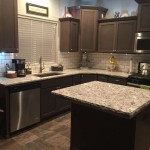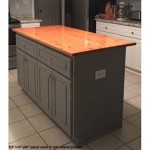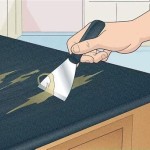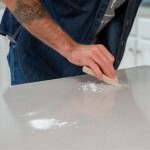Can a Laminate Countertop Be Painted?
Laminate countertops offer an affordable and versatile surfacing solution for kitchens and bathrooms. However, over time, they can show wear and tear, become outdated, or simply no longer match evolving design preferences. Painting offers a potentially cost-effective way to refresh these surfaces without full replacement. However, the smooth, non-porous nature of laminate presents unique challenges for paint adhesion. This article explores the feasibility and process of painting laminate countertops.
Understanding Laminate Composition
Laminate countertops consist of several layers: a base layer of particleboard or other substrate, a decorative layer of printed paper, and a protective top layer of melamine resin. This melamine resin, while durable and resistant to stains, creates a smooth, slick surface that paint struggles to grip. Successful painting requires thorough preparation and the use of appropriate primers and paints.
Steps for Painting Laminate Countertops
Painting laminate countertops involves a multi-step process to ensure proper adhesion and a durable finish. Skipping steps can result in peeling or chipping paint, negating the intended renovation.
1. Thorough Cleaning and Degreasing
The first step involves a thorough cleaning of the countertop surface. A heavy-duty cleaner designed to cut through grease and grime is essential. Any residue left on the surface can interfere with primer adhesion. After cleaning, the surface should be rinsed thoroughly and allowed to dry completely.
2. Sanding for Improved Adhesion
The smooth surface of laminate requires sanding to create a slightly roughened texture that allows the primer to grip. Fine-grit sandpaper (150-220 grit) is recommended to avoid deep scratches. The goal is to etch the surface, not to remove the melamine layer entirely. After sanding, the countertop should be wiped clean with a tack cloth to remove any sanding dust.
3. Applying a High-Quality Primer
Primer plays a crucial role in paint adhesion to laminate. An oil-based or bonding primer specifically formulated for slick surfaces is recommended. These primers are designed to create a strong bond with the laminate and provide a suitable base for the topcoat. Apply the primer evenly in thin coats, allowing each coat to dry completely before applying the next.
4. Choosing the Right Paint
Selecting the correct paint type is vital for durability and longevity. High-quality acrylic paints, specifically those formulated for kitchens and bathrooms, offer good resistance to moisture and wear. Consider using a semi-gloss or high-gloss finish, as these are easier to clean and more resistant to stains than matte finishes. Epoxy-based paints can also be a good choice for their exceptional durability and resistance to chemicals and abrasion.
5. Applying Multiple Thin Coats of Paint
Applying multiple thin coats of paint is preferable to one or two thick coats. Thin coats dry more evenly and are less prone to runs or drips. Allow each coat to dry thoroughly before applying the next. Following the paint manufacturer's recommended drying times is crucial for optimal results.
6. Sealing for Enhanced Protection (Optional)
While not strictly necessary, applying a clear sealant can provide added protection against wear and tear, especially in high-traffic areas. Water-based polyurethane sealers are a good option, offering durability and easy application. Multiple coats of sealant, with proper drying time between each coat, will provide the best protection.
Choosing the Right Tools and Materials
Using the correct tools and materials contributes significantly to the success of the project. High-quality brushes and rollers designed for smooth surfaces ensure even paint application. Using a tack cloth for dust removal, appropriate sandpaper for surface preparation, and a quality primer specifically formulated for slick surfaces are critical for achieving a professional finish.
Considerations for Longevity and Maintenance
While painting can revitalize a laminate countertop, it’s important to manage expectations. Painted surfaces, even with meticulous preparation and high-quality materials, may not have the same longevity as a new countertop. Regular cleaning with mild, non-abrasive cleaners is recommended to maintain the painted finish. Avoid harsh chemicals and abrasive cleaning pads as they can damage the paint.

How To Paint Laminate Counters Steven And Chris

How To Paint Laminate Countertops 4 Easy Actions

How To Paint Laminate Countertops Look Like Granite

How To Paint Laminate Countertops

Paint For Laminate Countertops How To Old

Diy Painted Laminate Countertops Plus An Update

How To Paint Laminate Countertops

Giani Countertop Paint Kit Update Old Laminate Countertops

How To Paint A Laminate Counter Top Postcards From The Ridge

Painting Laminate Countertops To Look Like Wood The Easy Affordable Way








